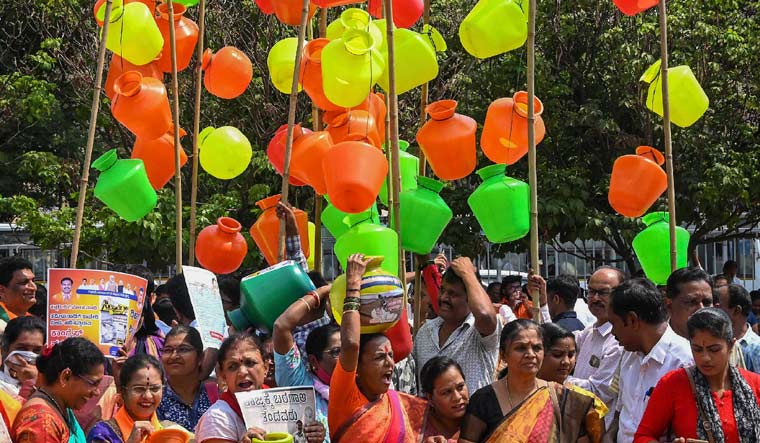Bengaluru is facing one of its worst water crises in decades. Residents are struggling to get water for their basic needs, parents want the schools to declare holidays, techies are demanding work from home, and some are even mulling moving to their native places till the crisis abates.
Of the nearly 13,900 borewells in Bengaluru, nearly 7,000 have dried up. Around 30-40 per cent of the state’s water needs are met through borewells. The areas where water sources are predominantly groundwater are the worst hit.
Deputy Chief Minister D.K. Shivakumar admitted that the shortage is in areas that are dependent on borewells.
At the core of this unprecedented water crisis in Bengaluru is the over-exploitation of groundwater.
Said S. Vishwanath, a water warrior from Bengaluru, “The ongoing water crisis in Bengaluru is out and out a groundwater crisis. The borewells and lakes in Bengaluru have dried up. No doubt the situation is exacerbated by insufficient rainfall last year, but the proliferation of unscientifically drilled borewells is the main cause of this situation.”
According to the Central government’s groundwater assessment 2023, all groundwater units in Bangalore (Urban) and Bangalore (Rural) are over-exploited. In Bangalore (Urban), the aquifers in Anekal, Yelahanka, Bangalore East, Bangalore North, and Bangalore South have been dug up much more than they are recharged. The situation is no good in Nelamangala, Doddaballapura, Devanahalli, and Hoskote units of Bangalore (Rural).
“India is one of the most borewell-intensive countries in the world,” said Arun Krishnamurthy of Environmentalist Foundation of India, a Tamil Nadu-based organisation. As per new statistics, India has around 40 million borewells and open wells and 250–260 cubic-km of groundwater is drawn every year, which is more than the USA and China combined. Groundwater provides 80 per cent of country’s drinking water and fulfils two-thirds of irrigation needs.
“Water usage in India is not regulated. We are all the time tapping into freshwater resources, especially groundwater. There is no proper mechanism of water reuse. In Bengaluru, the reserves have gone so low that a situation of ground zero has now emerged,” observed Krishnamurthy.
“The water from Cauvery serves only half the demand of Bengaluru’s water needs. The rest is met from borewells, a number of which have already dried up, signalling a dire need for regulated water management practices,” said Vishwanath, who has seen the situation getting worse in the IT capital. Calling for urgent interventions to strengthen the institutional and legal capacity for effective groundwater management, he said, “Actions must be driven by proper understanding of the groundwater situation, the nature of aquifers and supply perspectives.” “We have proposed to the state government to start a groundwater cell consisting of hydro-geologists and prepare a comprehensive groundwater management plan for Bengaluru.
Madhulika Choudhary, who revived Neknampur lake in Hyderabad, is of the opinion that there is a fundamental issue in the Bengaluru model of reviving lakes, which is a cause of concern. “They follow a model in which they drain out the lake and then wait it to get filled through surface run-offs. In my opinion that is not successful. In Hyderabad, we use a different model: we try and fill the lakes/ponds with water that is free of industrial pollution. The water, even domestic sewage, gets purified itself in the water bodies through processes like phyto-remediation. What this does is that it recharges groundwater round the year and not just when the lake is filled through rain or surface run-offs, which no one can predict or be sure of."
Bengaluru is on the edge of a precipice. The theme of World Water Day 2022 was ‘Groundwater: Making the Invisible Visible'. The city is witness to the havoc that can be caused by the mismanagement of this invisible but precious natural resource. Bangalore Water Supply and Sewerage Board has now mandated online approvals before digging any borewell and prohibited the use of potable water for non-essential purposes. However, such steps should not be limited to the times when “such extremities hit us.”



